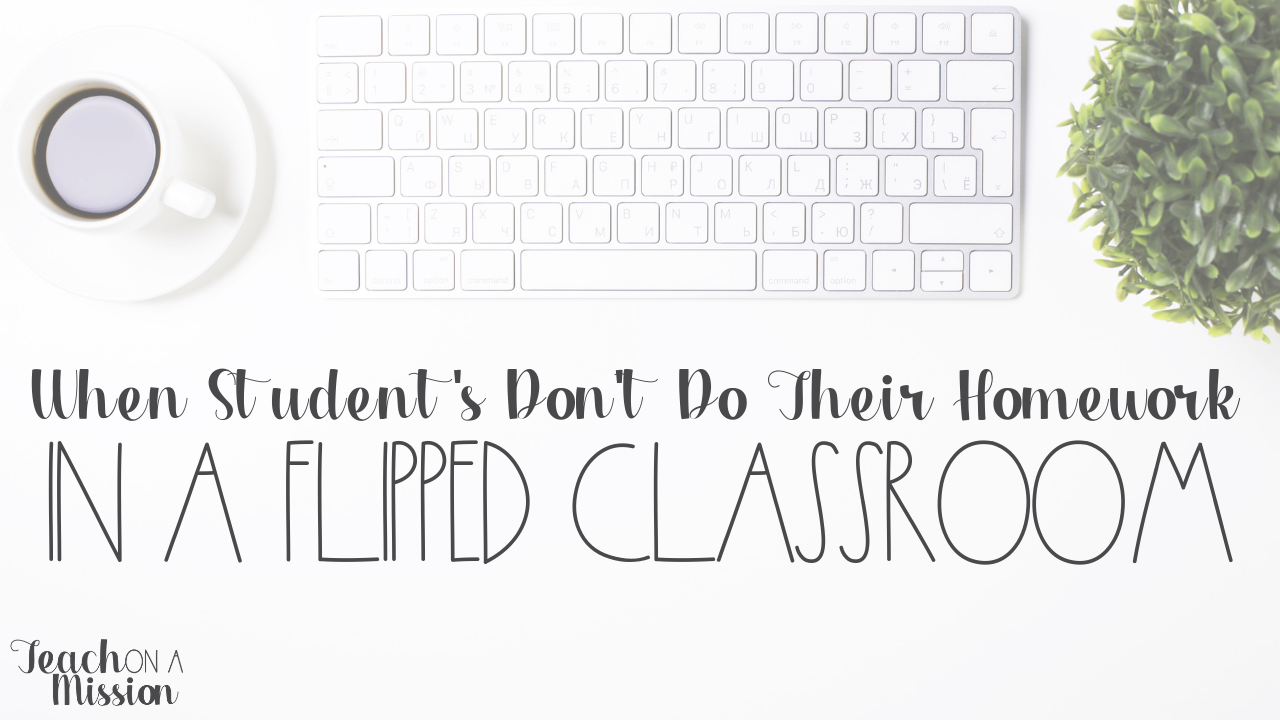When Students Don't Do Their Homework in the Flipped Classroom

Homework is a long, and hotly debated topic in the world of education. I don't need to remind any teacher of this debate. It's one that many teachers put a big, giant stake in the ground, and don't budge from assigning, and there are others that refuse to assign any at all.
There's tons of research for all grade levels that I won't bore you with, but do encourage you to check out sooner rather than later if you haven't yet, all about its effectiveness or lack thereof. But, really, no matter what the research says, homework is yet another pendulum that often swings from one extreme to the other as years pass and as kids are still being educated around the world.
What is homework in the flipped classroom?
In the "traditional" flipped classroom, if that's even a word you can use to describe flipping, homework is now what WAS in-class work. See, in the traditional classroom, students sit at their desks and receive information via the teacher through lecture - especially in the content heavy classes.
In the flipped classroom, just as a refresher for you, that "lecture" is now what students do at home. The main (but not only) purpose of this structure is so that students can now do what was traditionally homework (the practice and application assignments) in class with their classmates and teacher readily available to guide them and answer questions on what is arguably the more difficult aspect of learning... the practicing.
This does NOT mean that all flipped classrooms assign homework. If you haven't yet, PLEASE go get the workbook I've made for you where I help you get started flipping, and I do this by helping you decide which type of flipping is best for your classroom. Seriously, if you don't have it yet, go get it. I discuss the different types of learning and what homework looks like in each of those types.
Here's the thing, for all intents and purposes, let's say that you are going with the full, traditional flip where you have students watch your videos at home. As homework.
If we don't say that, then we really have nothing to say in this post... so, stick with me.
Ok, got it. But what if they don't do it?
Yes, back to the point. So you're you, and you're teaching, and you're assigning videos as homework - I recommend no more than 2 each week, but really that number depends greatly on your curriculum calendar and group of unique students.
Then, little Johnny rolls in to class one day and didn't watch the video you assigned, took ZERO notes, and those notes are absolutely imperative to his ability to do whatever amazing activity you have planned for class today, like, right now.
In most traditional classrooms, the students receives a zero on the assignment and everyone moves on with life. "Hey, Johnny. You didn't do your job, so you don't get paid."
First, trading grades as some kind of currency is just not how things should be - this was the entire focus of my master's thesis, but we won't go down that rabbit hole.
For now, let's focus on what this means in the flipped classroom.
If you assign a grade for homework (completion, in most cases), the student who didn't do it gets the zero and then never thinks about that homework again.
That means that that student did not receive the content you delivered and is at a serious disadvantage on the upcoming test or other form of assessment he's got coming up.
So, in reality, in the flipped classroom, because of the nature of homework, homework is even more imperative.
Now, to be honest that kind of scares me a bit. We are doing a disservice to students, especially those in populations that already struggle to accomplish homework because of having to work a job to support their families, or watch their siblings because both parents work around the clock to support their families. But I can confidently tell you that there are ways around this.
It's not easy, but it's doable. It's also not the point of this post, but I felt it was important to touch on just a bit.
Here's the kicker.
Homework in the flipped classroom can NOT be optional.
If you assign a grade for a homework assignment, you have made it optional. In many students minds, a zero is an option they are willing to accept.
This just can not be part of the system of how a flipped classroom works. The homework is too important.
Let's compare this to a traditional classroom for a moment. If a student were to miss (what is homework in the flipped classroom) lecture in a traditional classroom, what would they do to make it up? Probably nothing, because most of the time those notes aren't graded, or students aren't held accountable for them otherwise. If they do try to make them up, the student simply asks their neighbor for theirs and either copies it down, word for word, which equates to practicing their ABC's if you ask me, OR they join the 21st century and take a picture of it with their phone as if their image feed is equivalent to the neurological process of encoding and learning.
Ok, I digress. The point is, in the traditional classroom, if a kid misses your lecture, them making it up is at minimum incredibly less than mediocre learning.
But, in the flipped classroom, when they miss a lecture, and here's the part I need you to read thoroughly, AS LONG AS YOU DON'T MAKE IT OPTIONAL, they will still get the quality learning experience as if they had been there in person.
Bam, mic drop.
Ok, so how does this work then?
How do I make sure the homework isn't optional?
Great question.
And this is where your classroom culture means EVERYTHING, and has to be one that (safely) puts kids on the spot and holds them accountable for not doing their job.
You have to establish that the active process of learning the information (through your videos in this case) is more important than the probable discomfort they will feel in NOT being able to just go through the motions in your class.
Too many students are able to get by just going through the motions of school. They either don't do the notes, or take less than mediocre notes, not really knowing what it means to actively process and learn information anyway, but that's ok because they're able to just go through the motions in class, not get noticed, not get called on, pass the test, all is good.
NOPE!
Not in the flipped classroom.
And this might be what I love about it the most. It calls people on their crap of going through school without having learned very much at all. It makes the process of learning so individual and so accessible that it's hard for any student to get by in your class without learning a good majority of what it is you're throwing at them.
It's going to be REAL obvious in your class when a student hasn't taken the notes because of how active your students are in your class after they have taken said notes.
And this is where some work comes in on your part... when your students are IN your class, they have to be active - they have to be the ones doing the work. Or else, why flip? Why would you do all that work to make flipped videos, just so you can continue to be at the front and center of the class everyday?
That doesn't mean you're at your desk, or heavensakes, in the hallway, but it certainly means your students are in the center while you assume the role of guide on the side.
In setting up this structure, the student who doesn't do their notes is going to feel left out, and left behind.
Now, here's where you come in, again.
You have to be there in this moment when the student is feeling left behind and left out to find out what's going on, why they missed the notes.
Something is telling me that you know exactly what to do if there is a (legitimate) issue at home. And you know what to do if the student doesn't have access at home. (If you don't know what to do, stick around here at Teach On A Mission for a while and I can definitely give you some pointers)
But something else is telling me that you don't have much confidence in what to do if this child is lying to themselves on their ability to actually devote the time and energy to get their job done.
You've got to get real comfortable holding your students accountable, for reals, in the flipped classroom.
You've got to get real good at making your classroom a safe, comfortable, but honest and accountable atmosphere.
Your students, each and every one of them, need to know that you will HAVE THEIR BACK until the cows come home, but that very much includes making them look in the mirror. That very much includes having their backs when the ones who are hurting them and their chances at success is themselves.
This is a bit of a gut check for some teachers because in the flipped classroom, you now have time to have those one-on-one conversations. And it's those one-on-one conversations that can be really difficult.
But they are SO important, and SO effective (most of the time, and if done well).
Recap...
Let's do a recap real quick on how to hold kids accountable for their homework in the flipped classroom, making sure it is NOT optional.
- Your in-class activities have got to put students at the center of the room, and you as guide on the side. The reason being because a) classrooms should be student centered, duh, and b) because kids feel SUPER awkward when they can't participate and active in the room because they didn't do their notes.
- You've got to get real comfortable holding a mirror up to your students, and helping them get honest with themselves on their motivation, effort, and how they are lying to themselves.
- It's all about your classroom culture - is it safe? Are kids comfortable, but not too comfortable? And, with those, are you holding kids accountable? Are you calling them on the carpet when they aren't doing their job?
Alrighty, folks. I hope you could, at points, feel my emotion or even hear me talking through this post because that's very much what I tried to convey.
Whether you did or not, I encourage you to join me for our discussion of this topic over in our Sustainable Teacher community on Facebook. I go live in that group every week, giving tips, tricks, and answering questions about the flipped classroom, so don't miss it.
Here's the thing, this journey of flipping your classroom is not easy. It is not one for the faint at heart in the teaching world. But it is for those who want to see change in their classrooms and in their schools. It is for those who are committed to results in a classroom culture they are proud of.
And I truly hope I can support you on that journey.
Until next time,





